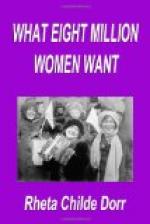Up to the time when the League began picketing there had been a little of this technical, and possibly an occasional act of real, violence. After the League took a hand there was none. Each group of union girls who went forth to picket was accompanied by one or more League members. Some of these amateur pickets were girls fresh from college, and among these were Elsie Cole, the brilliant daughter of Albany’s Superintendent of Schools, Inez Milholland, the beautiful and cherished daughter of a millionaire father, leader of her class, of 1909, in Vassar College, Elizabeth Dutcher and Violet Pike, both prominent in the Association of Collegiate Alumnae. These young women went out day after day with girl strikers, endured the insults and threats of the police, suffered arrest on more than one occasion, and faced the scorn and indignation of magistrates who—well, who did not understand.
The strike received an immense amount of publicity, and organizations of women other than the Women’s Trade Union League began to take an interest in it. They sent for Miss Marot, Miss Cole, Miss Gertrude Barnum, and other women known to be familiar with the industrial world of women, and begged for enlightenment on the subject of the strike. They particularly asked to hear the story from the striking women in person.
The exclusive Colony Club, to which only women of the highest social eminence are eligible, was called together by Miss Anne Morgan and several others, including Mrs. Egerton Winthrop, wife of the president of the New York Board of Education, to hear the story from the strikers’ own lips. The Colony Club was swept into the shirt-waist strike. More than thirteen hundred dollars was collected in a few minutes. A dozen women promised influence and personal service in behalf of the strikers.
A week later Mrs. O.H.P. Belmont, mother of the Duchess of Marlborough, leader of a large Woman Suffrage Association, engaged the Hippodrome, and packed it to the roof with ten thousand interested spectators. Something like five thousand dollars was donated by this meeting.
At the beginning of the strike fully five hundred waist houses were involved. Many of these settled within a few days on the basis of increased pay, a fifty-two-hour working week, and recognition of the union. Others settled later, and under the influence of the “uptown scum,” as the employers’ association gallantly termed the Women’s Trade Union League, the Colony Club, and the Suffragists, still others reluctantly gave in. Late in January all except about one hundred out of the five hundred had settled with the union, and only about three thousand of the workers were still out of work.
Women have been called the scabs of the labor world. That they would ever become trade unionists, ever evolve the class consciousness of the intelligent proletarian men, was deemed an impossible dream. Above all, that their progress towards industrial emancipation would ever be helped along by the wives and daughters of the employing classes was unthinkable. That the releasing of one class of women from household labor by sending another class of women into the factory, there to perform their historic tasks of cooking, sewing, and laundry work, was to result in the humanizing of industry, no mind ever prophesied.




